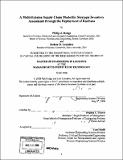A multi-echelon supply chain model for strategic inventory assessment through the deployment of kanbans
Author(s)
Hodge, Philip J. (Philip James); Lemaitre, Joshua D
DownloadFull printable version (12.60Mb)
Other Contributors
Massachusetts Institute of Technology. Engineering Systems Division.
Advisor
Stephen C. Graves.
Terms of use
Metadata
Show full item recordAbstract
As global competition in the manufacturing space grows, so do corporations' needs for sophisticated and optimized management systems to enable continuous flows of information and materials across the many tiers within their supply chains. With the complexities introduced by the variability in the demand for finished goods as well as by the variability in lead-time of transportation, procurement, production and administrative activities, corporations have turned to quantitative modeling of their supply chains to address these issues. Based on the data of a heavy machinery manufacturer headquartered in the US, this research introduces a robust model for the deployment of strategic inventory buffers across a multi-echelon manufacturing system. Specifically, this study establishes a replenishment policy for inventory using a multiple bin, or Kanban, system for each part number in the assembly of products from our sponsors tractor line. We employ a numerical simulation to evaluate and optimize the various inventory deployment scenarios. Utilizing several thousand runs of the simulation, we derive a generalized treatment for each part number based on an econometric function of the parameters associated with lead-time, order frequency, inventory value and order costing. The pilot for the simulation focuses on the parts data for three earthmoving products across eight echelons, but scales to n products across m echelons. Our results show that this approach predicted the optimal quantities of Kanbans for 95% of parts to a level of accuracy +/- 3 bins.
Description
Thesis (M. Eng. in Logistics)--Massachusetts Institute of Technology, Engineering Systems Division, 2008. Includes bibliographical references (leaves 100-102).
Date issued
2008Department
Massachusetts Institute of Technology. Engineering Systems DivisionPublisher
Massachusetts Institute of Technology
Keywords
Engineering Systems Division.